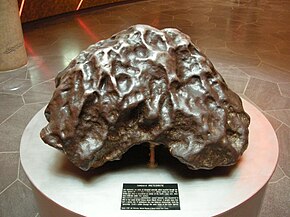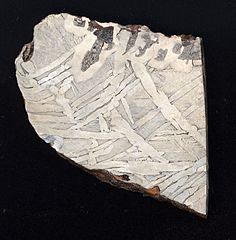
Back نيزك حديدي Arabic Железни метеорити Bulgarian Meteorit metàl·lic Catalan Siderit (meteorit) Czech Eisenmeteorit German Ferometeorito Esperanto Meteorito metálico Spanish شهابسنگ آهنی Persian Rautameteoriitti Finnish Météorite de fer French
| Iron meteorite | |
|---|---|
| — Type — | |
 | |
| Compositional type | Iron |
| Parent body | >50 |
| Composition | >95% iron, nickel, and cobalt; 5–25% nickel |
| TKW | c. 500 short tons (450 t) |
 Widmanstätten pattern as seen on an etched and polished slice of an olivine-free portion of the Seymchan meteorite.[a] Scale unknown. | |
Iron meteorites, also called siderites or ferrous meteorites, are a type of meteorite that consist overwhelmingly of an iron–nickel alloy known as meteoric iron that usually consists of two mineral phases: kamacite and taenite. Most iron meteorites originate from cores of planetesimals,[3] with the exception of the IIE iron meteorite group.[4]
The iron found in iron meteorites was one of the earliest sources of usable iron available to humans, due to the malleability and ductility of the meteoric iron,[5] before the development of smelting that signaled the beginning of the Iron Age.
- ^ "Tamentit". Meteoritical Bulletin Database. Lunar and Planetary Institute. 5 September 2024. Retrieved 2024-09-11.
- ^ van Niekerk, D.; et al. (August 2007). "Seymchan: A Main Group Pallasite - Not an Iron Meteorite". Meteoritics & Planetary Science. 42 (S8): A154. doi:10.1111/j.1945-5100.2007.tb00601.x.
- ^ M. K. Weisberg; T. J. McCoy, A. N. Krot (2006). "Systematics and Evaluation of Meteorite Classification/s". In D. S. Lauretta; H. Y. McSween, Jr. (eds.). Meteorites and the early Solar System II (PDF). Tucson: University of Arizona Press. pp. 19–52. ISBN 978-0816525621. Retrieved 15 December 2012.
- ^ Wasson, John T. (January 2017). "Formation of non-magmatic iron-meteorite group IIE". Geochimica et Cosmochimica Acta. 197: 396–416. Bibcode:2017GeCoA.197..396W. doi:10.1016/j.gca.2016.09.043.
- ^ "Meteoric Iron- Properties and Use". www.tf.uni-kiel.de. Retrieved 5 June 2021.
Cite error: There are <ref group=lower-alpha> tags or {{efn}} templates on this page, but the references will not show without a {{reflist|group=lower-alpha}} template or {{notelist}} template (see the help page).